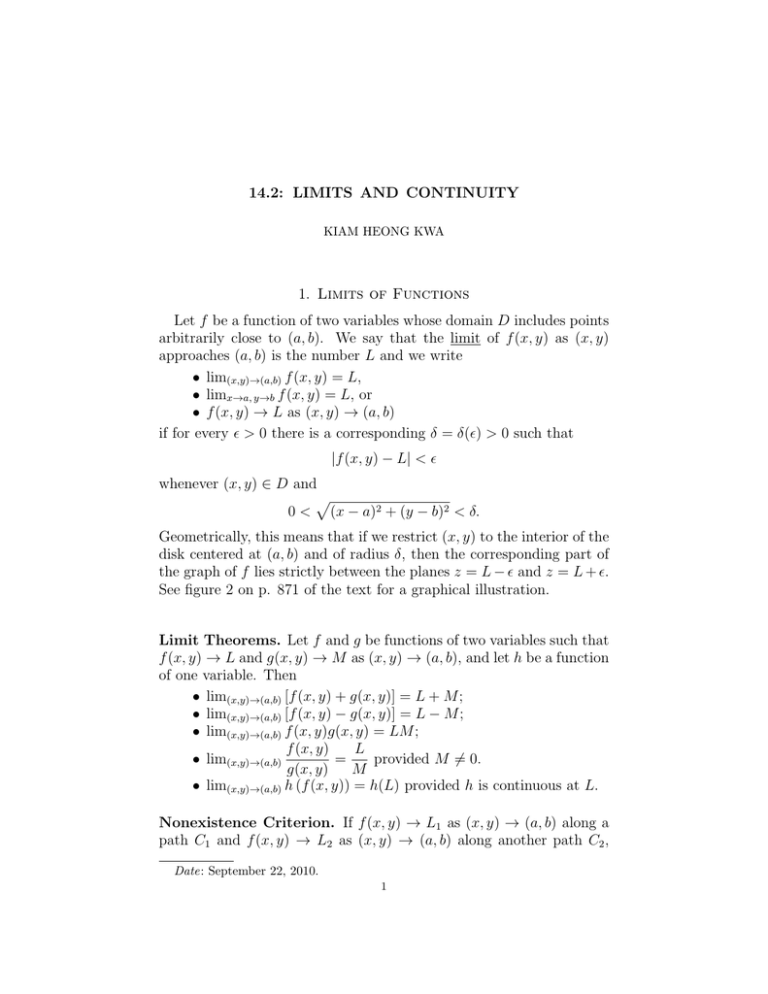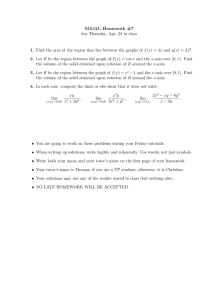14.2: LIMITS AND CONTINUITY 1. Limits of Functions Let f be a
advertisement

14.2: LIMITS AND CONTINUITY
KIAM HEONG KWA
1. Limits of Functions
Let f be a function of two variables whose domain D includes points
arbitrarily close to (a, b). We say that the limit of f (x, y) as (x, y)
approaches (a, b) is the number L and we write
• lim(x,y)→(a,b) f (x, y) = L,
• limx→a, y→b f (x, y) = L, or
• f (x, y) → L as (x, y) → (a, b)
if for every > 0 there is a corresponding δ = δ() > 0 such that
|f (x, y) − L| < whenever (x, y) ∈ D and
p
0 < (x − a)2 + (y − b)2 < δ.
Geometrically, this means that if we restrict (x, y) to the interior of the
disk centered at (a, b) and of radius δ, then the corresponding part of
the graph of f lies strictly between the planes z = L − and z = L + .
See figure 2 on p. 871 of the text for a graphical illustration.
Limit Theorems. Let f and g be functions of two variables such that
f (x, y) → L and g(x, y) → M as (x, y) → (a, b), and let h be a function
of one variable. Then
• lim(x,y)→(a,b) [f (x, y) + g(x, y)] = L + M ;
• lim(x,y)→(a,b) [f (x, y) − g(x, y)] = L − M ;
• lim(x,y)→(a,b) f (x, y)g(x, y) = LM ;
L
f (x, y)
• lim(x,y)→(a,b)
=
provided M 6= 0.
g(x, y)
M
• lim(x,y)→(a,b) h (f (x, y)) = h(L) provided h is continuous at L.
Nonexistence Criterion. If f (x, y) → L1 as (x, y) → (a, b) along a
path C1 and f (x, y) → L2 as (x, y) → (a, b) along another path C2 ,
Date: September 22, 2010.
1
2
KIAM HEONG KWA
where L1 6= L2 , then lim(x,y)→(a,b) f (x, y) does not exist.
Example 1. Find the limit, if exists, or show that the limit does not
exist in each of the following cases:
(a) lim(x,y)→(5,−2) (x5 + 4x3 y − 5xy 2 ). Ans: 2025
(b) lim(x,y)→(6,3) xy cos(x − 2y). Ans: 18
x2
(c) lim(x,y)→(0,0) 2
. Hint: Approach (0, 0) along the x-axis
x + y2
and the y-axis
6x3 y
(d) lim(x,y)→(0,0) 4
. Hint: Approach (0, 0) along the x-axis
2x + y 4
and the line y = x
2x2 y
. Hint: Approach (0, 0) along the x-axis
(e) lim(x,y)→(0,0) 4
x + y2
and the parabola y = x2
6x3 y
. Along the x-axis, i.e., the
2x4 + y 4
line y = 0, f (x, y) = f (x, 0) = 0. So, when (x, y) approaches (0, 0)
along the x-axis, f (x, y) → 0 = L1 . On the other hand, along the line
6x3 · x
= 2 whenever x 6= 0. Hence
y = x, f (x, y) = f (x, x) =
2x4 + x4
when (x, y) approaches (0, 0) along the line y = x, f (x, y) → 2 = L2 .
Since the two limits L1 = 0 and L2 = 2 of f when (x, y) approaches
(0, 0) along different curves are unequal, f has no limit when (x, y)
approaches (0, 0).
Solution for (d). Let f (x, y) =
2x2 y
. Along the x-axis, f (x, y) =
x4 + y 2
f (x, 0) = 0. So, f (x, y) → 0 = L1 as (x, y) approaches (0, 0) along
the x-axis. On the other hand, along the curve y = x2 , f (x, y) =
2x2 · x2
f (x, x2 ) = 4
= 1 whenever x 6= 0. Thus f (x, y) → 1 = L2 as
x + (x2 )2
(x, y) approaches (0, 0) along the curve y = x2 . Since the two limits
L1 = 0 and L2 = 1 of f when (x, y) approaches (0, 0) along different
curves are unequal, f has no limit when (x, y) approaches (0, 0).
Solution for (e). Let f (x, y) =
2. Continuity of Functions
A function f of two variables is said to be continuous at (a, b) if
f (a, b) =
lim
(x,y)→(a,b)
f (x, y).
14.2: LIMITS AND CONTINUITY
3
If f is continuous at every point in a set D, then it is said to be continous on D.
Remark 1. In view of the limit theorems, sums, differences, products,
and quotients of continuous functions are continuous on their common
domain.
Polynomial and Rational Functions. A polynomial of two variables is a sum of terms of the form cxm y n , where c is a constant and
m and n are nonnegative integers. A rational function is a ratio of
polynomials.
• A polynomial is continuous everywhere.
• A rational function is continuous everywhere except where its
denominator vanishes.
Example 2. Determine the set of points at which F (x, y) = ex
p
x + y 2 is continuous.
2y
+
Answer. {(x, y) ∈ R2 |x ≥ −y 2 }.
Example 3. Determine the set of points at which G(x, y) = ln(x2 +
y 2 − 4) is continuous.
Answer. {(x, y) ∈ R2 |x2 + y 2 > 4}.
Remark 2. The limits and the continuity of functions of n-variables
can likewise be defined. Refer to p. 876 of the text.

